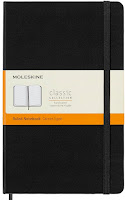
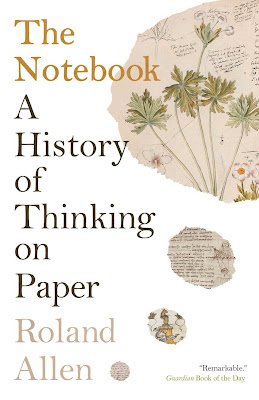 |
The Notebook by Roland Allen
(US publication: September, 2024) |
In his introduction to The Notebook: A History of Thinking on Paper, author Roland Allen describes the founding of the small company that currently manufactures Moleskine brand notebooks. An inspiration for this company came from the author Bruce Chatwin, who described how he made special efforts to obtain the earlier versions of these very special notebooks — but then, to his disappointment, the maker went out of business (creating an opportunity for the new business described by Allen). I remember reading this same passage in Chatwin’s book The Songlines.
The continuation of this iconic brand of notebooks still has an enormous following. You can buy a number of versions of the Moleskine notebook as well as many imitations on amazon, if you want one. If I wanted a notebook, I would want a Molskine!
The Notebook presents a fascinating history of all sorts of people using paper notebooks, beginning with artists at the start of the Renaissance, such as Giotto, who were figuring out how to make lifelike portraits.
A key technology enabled this new habit: the invention of paper and the development of manufacturing processes that made it very affordable compared to parchment, which was the previously available medium for written material. Paper had many advantages, which are explained in the book. The author continues the narrative about notebook keepers to the present. In the final few chapters he talks about the popularity of Bullet Journals. He describes the way that nurses wrote journals of people in intensive care during the covid pandemic — documents that helped the patients to understand the ordeal that they had been through. There’s a lot of really great material in this book!
The author studied the notebooks (or in most cases, photocopies of the original notebooks) that were created and used by many famous people throughout history. He didn’t neglect the notebooks, journals, diaries, commonplace books, ledgers and other personal records created by perfectly ordinary people. He consulted with the experts on each of the subjects of his chapters, with very readable and informative results. Finally he briefly returns to the topic of the iconic Moleskines.
If this intrigues you I very much recommend the book, but rather than summarize the chapters and list the many wonderful people whose notebooks were used to reveal all kinds of interesting things about them, I’m going to be an egotist and tell you about me and my notebook history.
I used to be a Notebook Person.
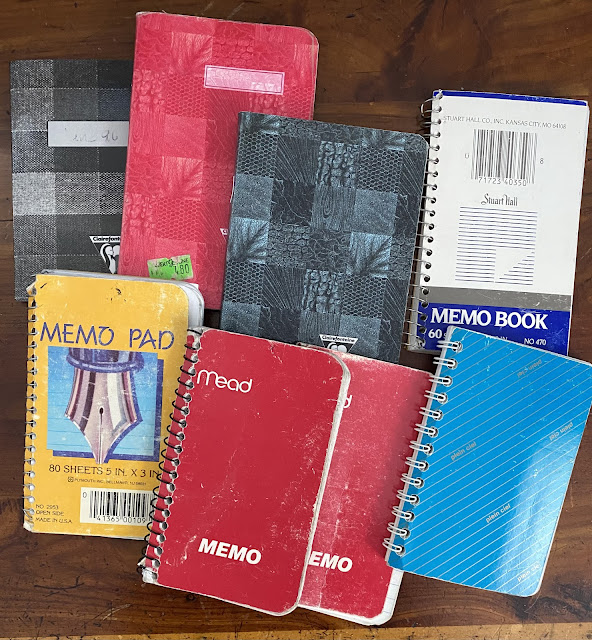 |
These are some of my notebooks from the 1990s, including notes on reading, phone numbers, etc.
The next photo shows notebooks I used (or in some cases did not use) in the early 2000s. |
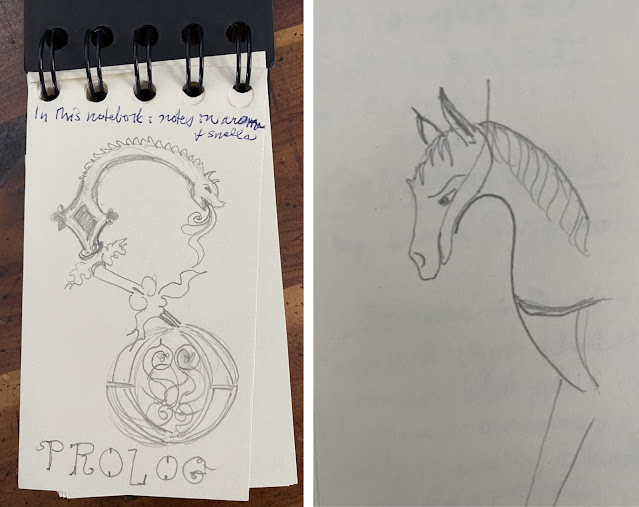 |
Sketches that I copied into a notebook from a Medieval manuscript I was looking at somewhere.
All photos © 2024 mae sander. |
As you can see from the photos, back then I used notebooks all the time. I kept a small one in my purse and made notes when I had to wait somewhere — whether I was waiting for a train, a plane, a dentist, or a movie. I took notes when I interviewed people for articles that I wrote at that time. If someone recommended a good book, I wrote down the name and author. Often I did follow up, looked up the library call number and wrote it in the notebook, and then would get a copy of the book and read it. Of course, throughout the years I've used other types of notebooks -- kids' autograph books, class notebooks in college, recipe notebooks, desk calendars, checkbooks, etc. But these carry-everywhere notebooks were my mainstay.
You can probably guess what happened next: in 2006, I decided to start a blog to record my thoughts when I traveled to Israel for a month. I had been there previously, and had sent many emails to friends and relatives describing my impressions, and several people had asked to be included in my list of recipients. So I decided that a blog would make it easier to share what I was writing down. Eventually, most of the note taking that I had done in notebooks became instead posts on my blog, including notes on books. And I continually found new subjects to write about.
Even while writing the blog, I continued to keep a little notebook in my purse to keep track of phone numbers, addresses, shopping lists, people’s recommendations of books to read or places to go, and simple things like that. A few years earlier, I had also begun carrying a small digital camera, which took the place of my crude sketching and often enabled me to get a quick record of an address or book title. So my little notebooks from those years aren’t as interesting as the earlier ones.
During the past decade, my iPhone has replaced everything: notebooks, address & phone lists, camera, photo archive (in the iCloud), shopping lists, and more. As they say — there’s an app for that! My handwriting isn’t even very legible any more. When I need to send a formal, handwritten note these days, I compose it on my iPad and then copy it onto a nice card with care and caution. When I want to remember an image, I take a photo with the iPhone. And when I want to remember an event or a book, I write them up as a blog post. The End.
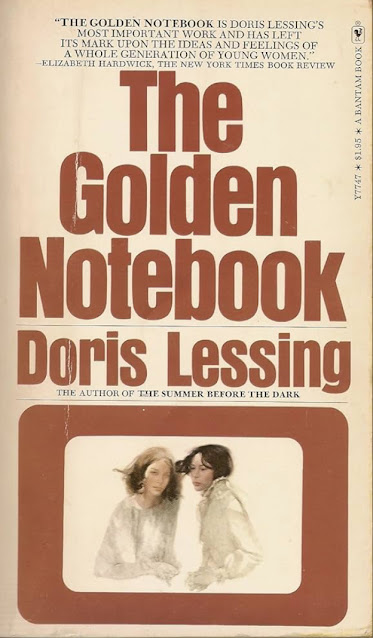 |
Doris Lessing’s famous work from 1962 is my favorite novel about notebooks.
It’s not mentioned in Roland Allen’s book. |







18 comments:
Aah, I remember I really liked this book! I think my favourite chapter was the one on ICU diaries; it's amazing to think a small, analog intervention can make such a difference.
Interesting topic for books. I have been keeping notes on the notes app on my phone. Have a great weekend.
I have a wall of boxes filled with old notebooks, some from the 1970s. Some are spiral notebooks, but I began to choose notebooks without lines early on. These old notebooks are filled with quotes and my impressions of books and little stories of the day and quick little drawings and lists. When I go through them, sometimes I wish I had spent more time writing down my joys instead of my complaints!
I love seeing your old notebooks, Mae. I do find it convenient to keep things in my phone. But I still love to keep a little notebook at the ready.
Our grandies use notebooks. Us, not so much. I'd be interested in reading about them, though.
I need to reread the GOlden Notebook as I remember enjoying it all those years ago. And your latest notebook book sounded so good I picked it up on my Kindle. I still keep a notebook, but I use a Japanese one I can draw in as well as write in (Hobonichi). It's pricey, but I like how summer humidity does let my writing/coloring utensils leak through. Thanks for sharing Mae. hugs-Erika
"...the notebooks, journals, diaries, commonplace books, ledgers and other personal records created by perfectly ordinary people"...YASSSSS I love them allllllllllllllllllllll!!!!
Thanks for sharing pics of your notebooks from the past. I love seeing them.
As for me, I have beds from Ikea with enclosed, under-bed storage and the storage compartment contains mostly my old notebooks, journals, diaries, etc. Many of them are Moleskines.
I love my laptop, Chromebook, and iPhone, but I'll always be an analog girlie. LOL
Very interesting post. I never knew notebooks were very popular.
I still use notebooks for planning (one to hold my plan for the week and a second for each day's to-do list). I like the idea of notebooks more than I like using them, especially with everything being searchable when I make notes on computers.
I wonder if most bloggers were/are notebook people. I kept 40 volumes of notebooks/journals from 8th grade through adulthood. I used moleskin notebooks for my todo lists for years. A new notebooks still makes me happy as it's full of possibilities.
I keep various notebooks for different subjects, garden notes, poems, books read, meditations, etc. An interesting subject and I'd like to get this book.
I can relate to your experience of using notebooks extensively in the past. They were an essential tool for me as well. However, like you, I've found that technology has made it easier to keep track of information and organize my thoughts.
It's interesting to hear about the different ways people use notebooks. Some people use them for journaling, while others use them for note-taking or creative writing. I use them for both. And I actually started creating and selling journals on Amazon recently. You can say I understand my products. Lol!
Thanks for sharing your insights on the history of notebooks and your personal experience with them.
I love paper notebooks and I use them all the time. I also read The Golden Notebook many years ago and must read it again. It's already on my Kindle so I have no excuses not to read it. :)
I still use a notebook. Old habits are reluctant to die, and in truth, I don’t want them too.
I've loved all styles and sizes of notebooks as far back as I remember. I always buy them in packs so I don't run out.
I wish I had the commitment to carry a notebook and write things down. I think of things all the time and decide to remember them, but never do. My desire for a notebook on me all the time is at war with my desire for the smallest purse/bag possible ;)
Interesting post! I am also a notebook person. Not as much as I was, but I do still carry one in my purse and have them laying around the house!
After all these years of blogging, goodreads, etc, a new notebook still makes me ridiculously happy!
I used to carry a notebook with me everywhere, too! Lists, phone numbers all kinds of info and empty pages to write things down such as directions! Remember the Thomas Guide? Things have changed. The notebook has an interesting history!
Post a Comment